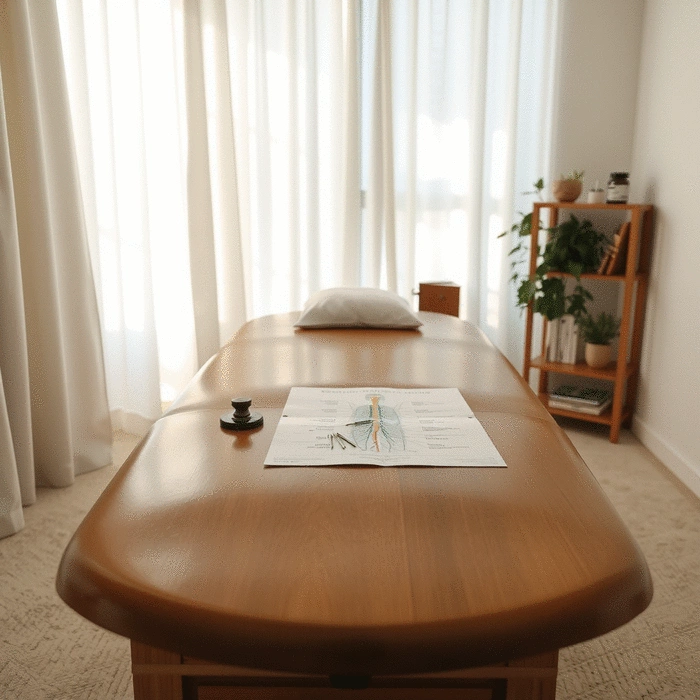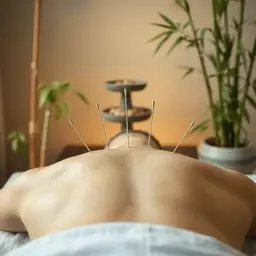Acupuncture's Place in Medicine

Posted on: 2025-07-20
By: Kaiya Whitmore
Acupuncture has journeyed from ancient practice to a respected therapy embraced by various medical communities. Its acceptance is a reflection of evolving attitudes towards holistic approaches in healthcare. As acupuncture gains traction, understanding its historical context and current perspectives is essential for both practitioners and patients. What lies ahead for this ancient art in modern medicine?
What You Will Learn
- Acupuncture involves stimulating specific points on the body to promote healing and balance, rooted in the concept of *Qi* flow.
- Historical acceptance varies by culture, with acupuncture being integrated differently in places like Japan and the United States, showcasing its adaptability.
- Western medicine has shown growing interest in acupuncture, particularly for pain management, despite initial skepticism regarding its efficacy.
- Complementary and alternative medicine communities fully embrace acupuncture as a holistic tool, often integrating it alongside other therapeutic practices.
- Research supports acupuncture's efficacy for conditions like chronic pain and anxiety, but challenges in establishing high-quality evidence remain.
- Major health organizations, including the WHO and NCCIH, recognize acupuncture's benefits, which is crucial for its integration into mainstream healthcare.
- The growing trend of patient adoption suggests an increasing demand for acupuncture services, reflecting a shift towards holistic and personalized care options.
- Engaging in informed discussions with healthcare providers about acupuncture can enhance understanding and facilitate better treatment decisions.
Acceptance Levels of Acupuncture in Different Medical Communities
The perspectives on acupuncture vary significantly across various medical communities, as shown in the visual representation below:
Western Medicine
Skepticism with growing interest in acupuncture for pain management.
Integrative and Complementary Medicine
Embraces acupuncture as a valuable tool for enhancing health.
Alternative Medicine
Fully embraced, with advocates highlighting its efficacy for various ailments.
International Perspectives
Acceptance varies, with notable growth in places like Australia.
Understanding the Perspectives on Acupuncture Across Medical Communities
Acupuncture, a practice with roots deep in ancient history, has gained a considerable following across various medical communities. As we explore the differing perspectives on acupuncture, it becomes clear that understanding its essence and historical context is crucial. By delving into how acupuncture is perceived through different lenses, we can appreciate its therapeutic potential and the rich background that informs these views. So, what exactly is acupuncture, and how has it evolved through time? For more insights into its benefits, consider reading about insights on acupuncture benefits.
Defining Acupuncture and Its Historical Context
Overview of acupuncture as a therapeutic practice
At its core, acupuncture involves inserting fine needles into specific points on the body to promote healing and restore balance. This ancient practice is grounded in the belief that energy, or *Qi* (pronounced "chee"), flows through pathways in our bodies. By stimulating certain points, we aim to enhance this flow, helping to alleviate discomfort and improve overall well-being. Isn't it fascinating to think about how something so simple can have profound effects on health?
Historical acceptance of acupuncture in various cultures
Acupuncture has been practiced for thousands of years, originating in China before spreading to other parts of the world. Each culture has embraced acupuncture in unique ways, adapting it to fit their specific beliefs and medical practices. For example, in Japan, acupuncture is often performed using a gentler technique, while in the United States, it has started to be integrated into conventional healthcare settings. This cultural diversity highlights how acupuncture has transcended borders and resonated with many.
Comparative Analysis of Acupuncture Acceptance in Different Medical Specialties
Western Medicine: Skepticism and Growing Interest
In Western medicine, acupuncture has faced its share of skepticism. Many practitioners require *strong evidence* before integrating any treatment into their practice. However, interest has been growing, especially as more clinical studies emerge. Some Western healthcare providers have begun to recognize acupuncture's benefits in pain management and other conditions. This shift signifies an exciting turning point in how acupuncture is perceived! Learn more about acupuncture's role in western medicine.
Integrative and Complementary Medicine: Embracing Acupuncture
In the realm of integrative and complementary medicine, acupuncture is seen as a valuable tool for enhancing health. Practitioners in this field often incorporate acupuncture into treatment plans alongside other therapies, such as nutrition and physical therapy. This holistic approach aims to address the whole person, rather than just symptoms. Common practices and beliefs about acupuncture in this context include:
- Promoting overall wellness
- Enhancing the effectiveness of other treatments
- Providing a non-invasive option for patients
Alternative Medicine: Advocacy and Full Acceptance
In the alternative medicine community, acupuncture is fully embraced and widely practiced. Advocates believe in its potential to treat a variety of ailments, from chronic pain to emotional issues. Personal experiences often fuel this advocacy, as many practitioners and patients share their success stories. This community plays a significant role in shaping the narrative around acupuncture and its legitimacy as a treatment method.
International Perspectives: Global Views on Acupuncture
Globally, acupuncture is viewed through various lenses, depending on cultural contexts. In many Asian countries, it's a mainstream therapy, while in others, it may still be regarded with skepticism. For instance, Australia has seen a significant increase in acupuncture practices being integrated into healthcare, reflecting a growing acceptance. Understanding these international perspectives can provide valuable insights into acupuncture's evolving role in global health.
The Role of Traditional Chinese Medicine (TCM) in Acupuncture
Fundamental principles of TCM in acupuncture
Traditional Chinese Medicine (TCM) forms the backbone of acupuncture practice. It emphasizes the balance of *Yin and Yang*, as well as the five elements, which are believed to affect our health. Understanding these principles can help practitioners tailor treatments to meet individual needs. TCM also embraces lifestyle factors like diet and emotional health, making it a comprehensive approach to wellness. To delve deeper into this connection, explore understanding acupuncture and Chinese medicine.
Integration of TCM with Western practices
As acupuncture gains traction in Western medicine, there is a growing trend toward integrating TCM principles. This fusion creates a more holistic approach to healthcare, helping patients benefit from both worlds. By combining the insights of TCM with evidence-based practices, we can develop treatment plans that are both effective and culturally sensitive.
Evidence-Based Assessments of Acupuncture’s Efficacy
Summary of clinical studies and systematic reviews
Research on acupuncture's efficacy has expanded significantly, with numerous clinical studies and systematic reviews emerging in recent years. These studies often highlight acupuncture's potential in treating conditions such as chronic pain, migraines, and anxiety. The results can vary, but many suggest positive outcomes, urging the medical community to consider these findings seriously.
Challenges in establishing high-quality evidence
Despite the growing body of research, challenges remain in establishing high-quality evidence for acupuncture. Variability in study designs, sample sizes, and treatment protocols can complicate results. Additionally, the subjective nature of pain and individual responses to acupuncture adds another layer of complexity. As we continue to explore these challenges, it's essential to remain open-minded and committed to understanding acupuncture's full potential.
Future directions for research and needed clinical trials
Looking ahead, future research on acupuncture should focus on high-quality clinical trials that address existing gaps in evidence. By refining methodologies and exploring specific applications, we can better understand the conditions where acupuncture excels. This ongoing commitment to research is crucial for bridging traditional practices with modern medical standards.
Integration of Acupuncture in Mainstream Healthcare
Role of acupuncture in pain management and treatment of chronic conditions
Acupuncture plays a vital role in pain management and the treatment of chronic conditions. Many patients find relief from ailments such as arthritis, back pain, and headaches through acupuncture therapies. With ongoing research supporting these benefits, it’s becoming more common to see acupuncture included as part of comprehensive treatment plans in healthcare settings.
Acceptance by major health organizations and institutions
Several major health organizations have begun to publicly endorse acupuncture, recognizing its potential to improve patient outcomes. Institutions like the World Health Organization (WHO) and the National Center for Complementary and Integrative Health (NCCIH) have established guidelines and resources for practitioners. This acceptance helps legitimize acupuncture within mainstream healthcare.
Patient adoption trends and their implications for practice
As more patients seek out acupuncture, trends indicate that its integration into healthcare will continue to grow. This change reflects a shift in patient preferences towards more holistic and personalized care options. With this rise in adoption, practitioners must be prepared to address questions and concerns to foster a supportive environment for patients navigating their health journeys.
Influence of Healthcare Organizations on Acupuncture Practices
World Health Organization (WHO) and acupuncture guidelines
The WHO has developed guidelines for acupuncture, emphasizing its efficacy and safety in treating various conditions. These guidelines serve as a foundation for practitioners, helping to standardize practices globally. By following WHO recommendations, acupuncturists can ensure that they provide safe and effective treatments.
National Center for Complementary and Integrative Health (NCCIH) contributions
The NCCIH plays a crucial role in funding research, training practitioners, and promoting education around acupuncture. Their support helps to validate acupuncture as a legitimate treatment modality and encourages healthcare providers to consider its integration into their practices. This collaboration between organizations fosters a deeper understanding of acupuncture's benefits.
American College of Physicians and their stance on acupuncture
The American College of Physicians has acknowledged acupuncture as a viable option for managing chronic pain. Their endorsement signals a significant shift in how acupuncture is viewed within the medical community, paving the way for greater acceptance and integration into treatment plans. This change is encouraging for practitioners like me at Acupuncture Perspectives, as it highlights the growing recognition of acupuncture's value.
Patient-Physician Dialogue on Acupuncture Recommendations
How physician attitudes influence patient choices
Physician attitudes play a significant role in shaping patient choices regarding acupuncture. When doctors express openness and support for acupuncture, patients are more likely to consider it as a treatment option. This dialogue between patients and physicians is essential for fostering an environment of trust and exploration.
Case studies and testimonials from acupuncture patients
Hearing from patients who have benefited from acupuncture can make a difference in motivating others to explore this therapy. For instance, I often share stories of individuals who have successfully managed stress or chronic pain through regular treatments. These personal testimonials not only inspire but also help demystify acupuncture for those unfamiliar with its practices.
Interactive Poll: Your Thoughts on Acupuncture
We want to hear from you! How do you view acupuncture in relation to conventional medical practices?
Summarizing the Current Landscape of Acupuncture in Medical Communities
As we reflect on the various perspectives surrounding acupuncture, it’s clear that opinions among physicians and practitioners are diverse and evolving. The increasing acceptance of acupuncture in different medical communities signifies a shift in how alternative therapies are viewed. This trend is not just a passing phase; it highlights a broader recognition of acupuncture's potential benefits in patient care.
Key Takeaways from Physician Perspectives on Acupuncture
A significant takeaway is the growing acceptance among healthcare providers. Many physicians now recognize acupuncture as a viable option for patients seeking relief from chronic pain and other conditions. Their views are shaped by several factors, including:
- Personal experiences with patients who benefit from acupuncture.
- Increased availability of research supporting acupuncture's efficacy.
- Educational initiatives that highlight the integration of acupuncture in treatment plans.
Another critical aspect is the role of evidence in shaping these opinions. In a world where data drives decisions, studies showcasing acupuncture's positive outcomes are pivotal. As practitioners witness the impact firsthand, they become more inclined to advocate for its inclusion in holistic treatment approaches.
Future Implications for Acupuncture Integration in Healthcare
Looking ahead, the potential for acupuncture use among patients is promising. As acceptance grows, we might see a greater demand for acupuncture services in traditional healthcare settings. Factors contributing to this anticipated growth include:
- Increased public awareness of acupuncture benefits.
- More healthcare providers recommending it as a treatment option.
- Expansion of insurance coverage for acupuncture treatments.
Moreover, fostering ongoing dialogue among medical communities will be essential. This exchange of ideas can help bridge gaps between traditional and alternative medicine, ultimately benefiting patients seeking comprehensive care. I believe that at Acupuncture Perspectives, we have a role to play in facilitating these conversations and promoting understanding.
Encouraging Informed Decisions on Acupuncture Treatments
As you explore acupuncture, it’s important to have informed discussions with your healthcare provider. Here are some common FAQs about acupuncture that can guide your conversations:
Frequently Asked Questions (FAQs)
- What is acupuncture?
- Acupuncture is an ancient therapeutic practice involving the insertion of fine needles into specific points on the body to promote healing and restore balance, based on the concept of *Qi* flow.
- How does Western medicine view acupuncture?
- Western medicine has historically viewed acupuncture with skepticism but shows growing interest, especially for pain management, as more clinical studies emerge supporting its efficacy.
- Do major health organizations recognize acupuncture?
- Yes, major health organizations like the World Health Organization (WHO) and the National Center for Complementary and Integrative Health (NCCIH) recognize acupuncture's benefits and have established guidelines for its practice.
- What role does Traditional Chinese Medicine (TCM) play in acupuncture?
- TCM forms the fundamental basis of acupuncture, emphasizing the balance of *Yin and Yang* and the five elements. These principles guide practitioners in tailoring treatments and provide a comprehensive approach to wellness.
- What conditions can acupuncture effectively treat?
- Research and clinical experience suggest acupuncture can be effective for conditions such as chronic pain, migraines, anxiety, arthritis, and back pain, among others.
- Are there any side effects or risks associated with acupuncture?
- When performed by a qualified practitioner using sterile needles, acupuncture is generally safe with minimal risks. Minor side effects might include slight bleeding, bruising, or soreness at the needle insertion sites.
- How many sessions are typically needed to see results?
- The number of sessions varies depending on the individual and the condition being treated. Some people experience relief after a few sessions, while chronic conditions may require a longer course of treatment.
- What conditions can acupuncture effectively treat?
- How many sessions are typically needed to see results?
- Are there any side effects or risks associated with acupuncture?
I encourage you to share your experiences with acupuncture and ask your healthcare providers questions. Engaging in these conversations not only enriches your understanding but also helps create a community that values holistic health. Together, we can pave the way for a more integrated approach to wellness, where acupuncture finds its rightful place alongside traditional treatments.
Recap of Key Points
Here is a quick recap of the important points discussed in the article:
- Acupuncture is an ancient therapeutic practice that involves inserting fine needles into specific points to promote healing and restore balance.
- The historical acceptance of acupuncture varies by culture, with practices evolving in countries like Japan and the United States.
- Western medicine is witnessing a shift towards recognizing acupuncture's efficacy, particularly in pain management, despite initial skepticism.
- Integrative and complementary medicine embraces acupuncture as a holistic treatment option, often used alongside other therapies.
- Traditional Chinese Medicine (TCM) principles, such as the balance of Yin and Yang, underpin acupuncture practices and enhance its therapeutic approach.
- Research supporting acupuncture is expanding, but challenges remain in establishing high-quality evidence due to variability in study designs.
- Major health organizations like the WHO and NCCIH are beginning to endorse acupuncture, paving the way for greater acceptance in mainstream healthcare.
- Patient-physician dialogues about acupuncture significantly influence patient choices, emphasizing the importance of education and shared experiences.
- As awareness and acceptance of acupuncture grow, it may see increased demand and integration into traditional healthcare settings.
 Acupuncture, an ancient practice with roots in Traditional Chinese Medicine, has transcended cultura
Acupuncture, an ancient practice with roots in Traditional Chinese Medicine, has transcended cultura
 As the demand for alternative therapies grows, the need for well-trained acupuncturists becomes para
As the demand for alternative therapies grows, the need for well-trained acupuncturists becomes para
 As global health trends evolve, ancient practices like acupuncture are finding their place in modern
As global health trends evolve, ancient practices like acupuncture are finding their place in modern